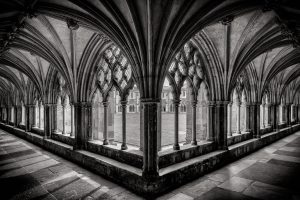Photo of the Day – 7 April 2017: Cloisters
This is what could be described as a “classic” shot of the cloisters at Norwich Cathedral. A polite way of saying that others have done it before. It would be a surprise if they had not; few worthwhile locations are unique in photography, especially in the UK. Only the early pioneers who were shooting their subjects for the first time could have that experience. I know that there have been others since, as I shared the shot and location with those in my camera club who were on our recent trip to Norfolk. And why not? Should I deprive my friends of the opportunity to take what I and others had seen before them?
Creative seeing or merely copying?
In his book “The Art of Photography”, Bruce Barnbaum describes how he first encountered English cathedrals in 1980. Until that time, he had had little interest in architectural photography, but these monumental buildings were a revelation. He changed his itinerary to visit as many as possible during his two week trip and returned the following year for five weeks specifically to photograph them. There are many examples in his book and they are beautiful pictures, reflecting both the skill of the artisans who built them and the craft of the photographer in capturing their essence.
Barnbaum can scarcely claim to have uniquely discovered the magnificence of English cathedrals. After all, many of these buildings can trace their origins back nearly 1,000 years. Indeed, he makes no such assertion. What he did do was encounter them for himself and recognise their potential for photography. In shooting them, he applied his own interpretation of their grandeur.
Compare Barnbaum’s experience to that of Michael Freeman, who was one of the first photographers to depict Angkor Wat after the Khmer Rouge regime collapsed. The ruins were known to the Victorians, but the political situation in Cambodia meant they were inaccessible during the time when international travel was becoming more widely available. Freeman has made several trips there and on one occasion was astonished to see another photographer with his book, attempting to recreate the images he had taken some years earlier.
It is not possible to know the other photographer’s motivation, nor the results he achieved. If the intention was to produce shots on a par with Freeman’s, he most likely did not succeed. Conditions would not have been the same and it is questionable whether someone who resorted to copying compositions would have the requisite skills.
Photographing a building intended to impress with its visual appeal can look deceptively easy. Surely it is the architect who has done all the heavy lifting? Yet there is more to it than simply pointing the camera at an attractive section of masonry. What is the light doing? Would it be better at a different time of day? It is impossible to show the building in its entirety, so where do the edges of the frame fall? How will the resulting image be processed? Cathedrals are popular, so obtaining images without anyone in them can be an additional concern.
It is entirely possible that someone could produce work akin to Barnbaum’s without having reference to his images. Both could create pictures that showed how they felt about the places they were photographing, imparting something of themselves. If Freeman’s plagiarist was disappointed with his results, he could still have gained something from the experience. One way to develop is to copy others and encounter similar issues, working out the best way to solve them. It is only by shooting and learning from the mistakes as well as the successes that we grow as photographers.
Making an image for its own sake
Returning to my picture, some might consider it derivative, comparable to what has been done before. I disagree, although what others think is not my concern. I have wanted to capture a cloisters scene for a while and it is the first occasion I have felt happy with the result. That it is similar to the work others might have done is no reason not to do it for myself. Besides, no two images will ever be exactly alike, even if taken at the same location. Were exclusivity the sole criterion for image making, very few would ever be produced. And photography would be the poorer for it.
Finally, a technical note on which to conclude. The lens used for this shot is again the Fuji-X 14 f/2.8 which I used for my “Tracks” photo the previous day. I said in that post that once on the camera I had seen no good reason to remove it and it was still there as I explored the cathedral.
This post is part of my occasional “Photo of the Day” series. I publish shots which I think might be of interest and tell the story behind them. They might not necessarily be portfolio standard images, nor the final version, but still be of sufficient interest for inclusion in my blog. If I do not show a shot on any given day, it does not mean that I did not take any photographs, just that I did not get anything worthwhile. For me, that is part of the fun of photography. Not knowing what I will find on a shoot when I have nothing planned.
